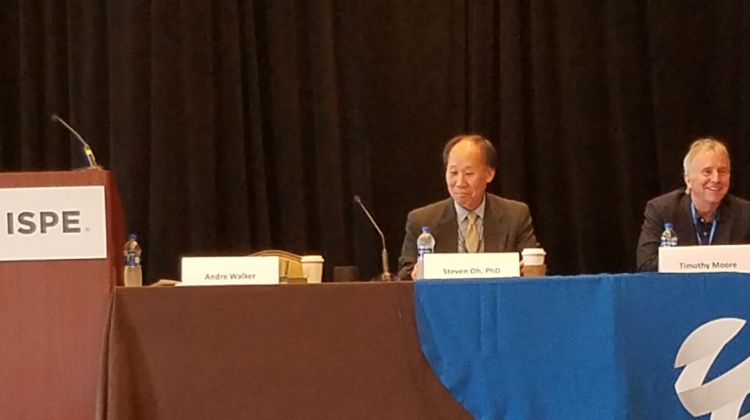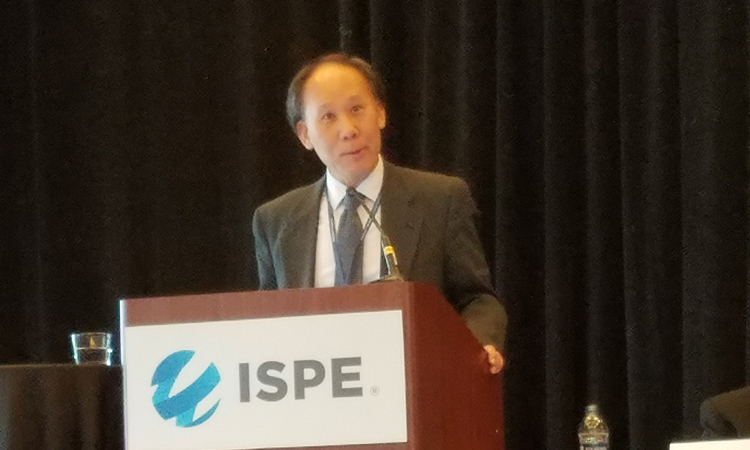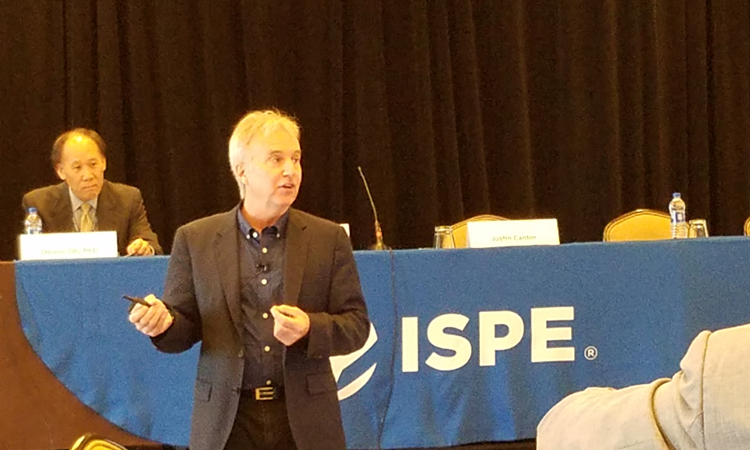2018 ISPE Biopharma Manufacturing Conference Recap: Future is Now

2018 ISPE Biopharmaceutical Manufacturing Conference on 10-12 December in Huntington Beach, California, provided information about the future-oriented developments in the burgeoning area of biopharmaceutical manufacturing—and also shared insights into the achievements that are already underway. This conference was ISPE’s third on biopharma so the focus toward the future was appropriate, noted Andre Walker, Principal, Andre Walker Consulting and chair of the conference program committee.
“We used to talk about monoclonal antibodies, and now we will talk about new modalities,” he said at the opening of the conference, noting that biopharma is moving toward “turbo-charged” manufacturing, like what is possible with continuous manufacturing. “Our job is to make it compliant and an economic reality for the patients,” Walker said. “We’ve gone from small molecule to large, now we’re going even larger to complete cells.” But new modalities are also “going smaller” as pharma companies that previously strove to keep viruses out of their facilities are retooling to manufacture them. He also anticipates a coming together of the typical small molecule/large molecule divide. For instance, experience with organic solvents is rare in bipharma plants, but “you need them to make nucleic acid therapeutics, and potent compound experience is essential when producing antibody drug conjugates.”
Continuous downstream biopharma is in its early stages, Walker noted—some work has already been accomplished, although not in commercial usage yet, but companies large and small are investing in its development. He encouraged attendees to take the lessons learned from small molecule developers into the biologics CM space. “It’s up to us to use the regulatory path [small molecule developers] cleared for us to make it a reality. New people, new skills, and new processes are needed.”
WORKING WITH REGULATORS
Regulatory approvals for fast-moving technologies in biopharma are needed, and the Biopharma conference provided another opportunity for ISPE to bring regulators together with the industry. In his opening remarks at the start of the conference, John Bournas, ISPE CEO and President, observed ISPE’s unique interactions with regulatory agencies including the presence of regulators on ISPE working teams, the recent recognition of ISPE as a stakeholder to the EMA, and over 140 regulatory speakers from agencies around the world presenting at various ISPE events.
Several presenters from the US FDA described the steps the agency is taking to embrace innovations and partner with pharmaceutical company developers in moving new approaches forward in the regulatory process.
In the opening plenary session on 10 December, Steven S. Oh, Deputy Director, Division of Cellular and Gene Therapies, Office of Tissues & Advanced Therapies (OTAT), CBER/FDA, provided details about some of the FDA’s activities in support of innovative and emerging technologies. Early interaction with the FDA on biopharma product development is encouraged through INTERACT (Initial Targeted Engagement for Regulatory Advice on CBER producTs, formerly pre-pre-IND interaction), which can garner early FDA feedback.
Oh described recently approved cell therapy and gene therapy products, including:
- Provenge (sipuleucel-T): Autologous T-cell immunotherapy for treatment of asymptomatic or minimally symptomatic metastatic castrate resistant (hormone refractory) prostate cancer.
- Luxturna (voretigene neparvovec): Adeno-associated virus vector-based gene therapy for treatment of patients with confirmed biallelic RPE65 mutation-associated retinal dystrophy.
- Yescarta (axicabtagene ciloleucel): CD19-directed genetically modified autologous T cell immunotherapy for treatment of adult patients with relapsed or refractory large B-cell lymphoma (DLBCL), primary mediastinal large B-cell lymphoma, high grade B-cell lymphoma, and DLBCL arising from follicular lymphoma.
- Kymriah (tisagenlecleucel): CD19-directed genetically modified autologous T cell immunotherapy for treatment of patients up to 25 years of age with B-cell precursor acute lymphoblastic leukemia (ALL) that is refractory or in second or later relapse.

He outlined guidance and resources of interest to biopharma product developers, including Expedited Programs for Serious Conditions—Drugs and Biologics (2014); 21st Century Cures Act Regenerative Medicine Therapies (2016); Expedited Program for Regenerative Medicine Therapies for Serious Conditions: Draft Guidance for Industry; and a web site with information about the RMA Designation and early FDA interactions.
RMAT status designation may be sought from the FDA for drugs that are regenerative medicine therapy (RMT) which includes cell therapies, therapeutic tissue engineering products, human cell and tissue products, and combination products. Oh said that 22 RMAT designation requests have been granted as of 13 June 2018; six are pending, and 33 have been denied. The denials tend to be for administration reasons such as an inactive IND or no preliminary clinical evidence submitted or insufficient preliminary clinical evidence.
CONTINUOUS MANUFACTURING AND FDA
Patricia Hughes, Branch Chief, Division of Microbiology Assessment, FDA/CDER said during her plenary session presentation on 12 December that the FDA is actively working to support industry innovation. She provided some background about recent steps taken by the agency in support of innovative technologies.
Finalized guidance from CDER in September 2017, Advancement of Emerging Technology Applications for Pharmaceutical Innovation and Modernization, provides industry with information to support early input by FDA, including pre-submission questions and proposals for emerging technology to the Emerging Technology Team (ETT).
Recent technology advances are creating opportunities to simplify manufacturing operations and improve microbial control, Hughes said. Cell culture, purification, and aseptic operations are all areas that stand to benefit from new developments as well. New developments that Hughes highlighted include single-use systems (SUS), continuous manufacturing (CM), and PAT including Advanced and Rapid Microbial Methods (ARMM).
CM in particular shows promise for biopharma through significant improvements in cell line development, cell expansion, cell transfers and protein expression, and reduced microbial contamination rates due to use of SUS in spite of the very long perfusion processing times and complex perfusion operations.
Next in CM: integration of both drug substance upstream and downstream operations; continuous processing from the bioreactor to purification; and continuous chromatography steps. The FDA fully support this approach, she noted, and indicated that partially integrated continuous biomanufacturing processes have been approved using ballroom design facilities.
Hughes noted that microbial monitoring is still mostly offline although the industry is working to develop and implement ARMM. She is looking ahead to aseptic improvements that integrate ARMM with separation technology such as isolators and closed RABS (restricted access barrier systems), automation that eliminates human/process interaction, and equipment designs that minimize risks during transfers.
“It’s up to us to use the regulatory path [small molecule developers] cleared for us to make it a reality. New people, new skills, and new processes are needed.”
FUTURE TRENDS
Timothy Moore, Executive Vice President, Technical Operations at Kite, a Gilead Company, shared the views of a company involved in biopharma development in a presentation during the opening plenary on Cell Therapy-The Future. Their therapy Yescarta is one of the first CAR-T therapies to be commercialized. CAR-T and TCR are cell therapy platforms utilizing receptors engineered to recognize tumor cells and trigger a targeted immune response.

There is much opportunity for development, Moore noted, in areas such as establishing efficacy against hematological cancers for patients with limited options; expand indications in earlier stages of hematological cancers; explore solid tumors; rapidly evolving technologies; and leveraging a platform for targeted therapies in other indications.
Challenges faced include complex and resource-intensive manufacturing technology; each patient is a unique batch, requiring chain of identity and chain of custody; adverse events need to be minimized and managed; variability in incoming patient cells reduces manufacturing consistency; and timing and scheduling are critical.
He outlined the ultimate goals for product development: products with excellent safety and efficacy profiles; innovative therapies for patients with hematological and solid tumors; and scaleable manufacturing process to lower the cost of goods and meet market demands.
Moore noted that there are many new entrants to the cell therapy space in both autologous and allogeneic sectors, and many new entrants are expected to reach commercial status as soon as the second half of 2019. Companies entering the market must continue to manage a complex pipeline and scale commercial operations effectively to stay competitive. CAR-T and TCR are the platforms being used, utilizing receptors engineered to recognize tumor cells and trigger a targeted immune response.
With development, cell therapy knowledge is evolving. Moore talked about his company’s product, Yescarta, a treatment for non-Hodgkin lymphoma which obtained US approval in October 2017 and EU approval in August 2018. Kite is working to reach patients earlier in the course of treatment, and is investigating new indications including mantle cell lymphoma and follicular lymphoma. The company is also studying combination with other immune-oncology agents with the goal of improving efficacy.
Kite is developing KITE-585, which targets B-cell maturation agent (BCMA) expressed in multiple myeloma; this is now in Phase 1 clinical trials as an investigational treatment for multiple myeloma. Another program aimed at solid tumors is also in development, KITE-718 is a cell therapy engineered to express T cell receptors (TCRs) that target MAGE A3/A6 proteins, frequently found in bladder, esophageal, head and neck, lung and ovarian tumors. KITE-718 is in Phase 1 clinical trials, and Kite is partnering with the National Cancer Institute to help accelerate TCR research.
Future trends in cell therapy development, Moore said, will focus on automating manufacturing processes, business systems that support the move to cell therapy maturity, end-to-end tracking identity and materials, and end-to-end connectivity. Moving from centralized to decentralized manufacturing models will increase the reach of cell therapy, and manufacturers will need to address attributes including allogeneic versus autologous; feasibility of process and raw material controls; technology options; compliance and regulatory requirements; staffing needs and training; and economic viability.
WOMEN IN PHARMA
A roundtable discussion on Women in Pharma opened the second day of the conference, 11 December, with six women sharing their experiences in diverse careers, discussing the challenges they faced, and how they overcame them to achieve success in pharma careers. Participants included
- Cindy Capeloto, Site Director, Quality Management, Shire
- Amie Clarke, Senior Director, Corporate Security and Crisis Management, Gilead Sciences, Inc.
- Rose Doolittle, Senior Director, Pharmacovigilance CAPA Center of Excellence, Johnson & Johnson
- Lisa Rappl, Associate Director, Asset Quality Lifecycle, BioMarin Pharmaceutical, Inc.
- April Shiflett, Process Development Principal Scientist, Amgen, Inc.
- Melody Spradlin, Senior Director, Facilities Engineering, Gilead Sciences, Inc.
Tips for success offered by panel participants included:
- Look for opportunities to take on something new and be willing to take risks: Shiflett.
- Having the right team around you will help you achieve balance. Follow the Three Ds: develop yourself, develop your team, deliver on results. This will help you have something to show when you look for your next job: Capeloto.
- Don’t apologize if you don’t need to: Clarke.
- Know your strengths and use them. Try to find something in common with everyone you work with to connect across generations: Rappl.
- Change is good—let go of fear and inertia about change and see change as an opportunity: Doolittle.
- Be resilient in times of change. Be curious, understand the drivers for change and what you can and can’t control. Hold yourself accountable for demonstrating resilience during times of change: Spradlin.
At the end of the session, a new Women in Pharma initiative under development was shared with attendees: mentor circles will be launched in 2019. The circles will be groups of 10 to 15 people around the US and also Europe; they will meet regularly in person or virtually depending on the membership. An ISPE survey early in 2019 will generate additional information, and Women in Pharma is seeking hosts and speakers.
MORE COVERAGE OF BIOPHARMA CONFERENCE
Watch for more posts in iSpeak and articles in Pharmaceutical Engineering about the Biopharma conference in 2019.
Disclaimer: This is brief and informal synopsis of information from US FDA during presentations at the ISPE Biopharmaceutical Manufacturing Conference on 10-12 December 2018. It has not been vetted by any agency and does not represent official guidance or policy of the FDA.



